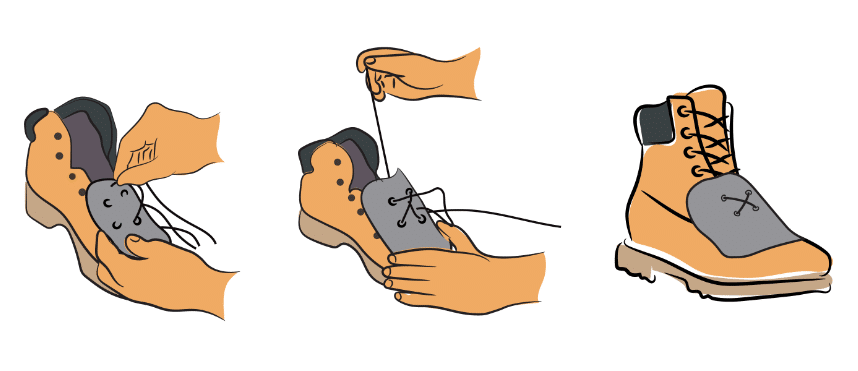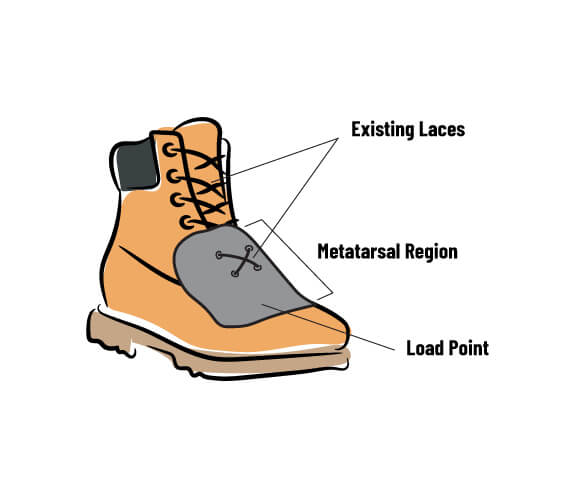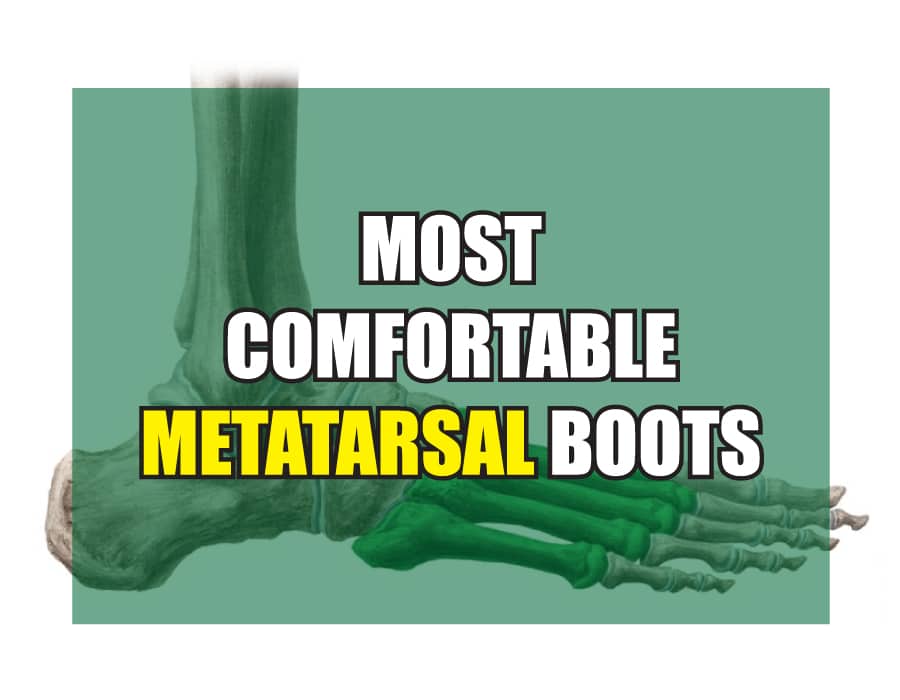Here you can find precise and vital information about what is a metatarsal guard and how it protects you from workplace hazards.
Before discussing a metatarsal guard, it is crucial to understand the metatarsal region and why it needs protection. The metatarsal area is the most vulnerable area of the feet and refers to the bones extending from the toes to the ankle. These bones are prone to injuries and may fracture easily upon impact and pressure.
So, what is a metatarsal guard? It is a protective attachment made of steel, aluminum, or lightweight composite material to shield the metatarsal region of the feet from fractures.
A metatarsal guard attachment enhances your regular steel toe protection a few notches higher by shielding the entire metatarsal region rather than just your toes. They work similar to steel toes and resist the impact of heavy objects dropping on your feet but cover the instep of your feet, thus doubling up the protection.
We hope you love the products we recommend! Just so you know, when you buy through links on our site, as an Amazon Associate we may earn an affiliate commission. This adds no cost to our readers.
Contents
Understanding Metatarsal Guards
What Are Metatarsal Guards?
Metatarsal guards are protective devices designed to safeguard the foot from a variety of hazards. These guards are generally worn in workplaces where employees are at risk of getting injuries to the foot.
How Do They Function To Protect The Foot?
Metatarsal guards protect the foot from falling objects, chemicals, and other hazards by taking the brunt of the impact. They work by providing an additional layer of protection for the metatarsal bones on the top of the foot. The guards reduce the risk of fractures, cuts, and bruises that can be caused by workplace accidents.
Here are some key features of metatarsal guards that make them effective:
- They are made of sturdy materials that can withstand the impact of heavy objects.
- They are padded for extra cushioning, which reduces pressure on the foot.
- They come in various styles to suit different occupations and work environments.
What Are The Different Types Of Metatarsal Guards Available In The Market?
Metatarsal guards come in different types and styles. Here are some of the most common ones:
- Strap-on metatarsal guards: These attach to your shoes with straps and provide protection to the top of the foot.
- Lace-up metatarsal guards: These are integrated into work boots and provide comprehensive protection to the foot.
- Hinged metatarsal guards: These provide complete coverage to the metatarsal bones and can be adjusted to provide a comfortable fit.
- Internal metatarsal guards: These are located inside the boot and provide an additional layer of protection to the foot.
- Removable metatarsal guards: These are separate from the shoes and can be removed when not in use.
By wearing the right type of metatarsal guard, you can safeguard your feet from injuries and ensure a safer work environment. Consider your work environment, type of hazards you face, and comfort levels when selecting the type of metatarsal guard to use.
Why Are Metatarsal Guards Necessary?
Safety boots are an indispensable part of personal protective gear necessary for workers involved in risky jobs. Professions like construction, warehousing, transportation, mining, etc., pose potential threats all the time. Such dangerous professions require workers to have safety boots on their feet to minimize accidents.
However, most workers are unaware of the features essential for optimum protection in their daily jobs. Not many people have adequate knowledge regarding what are metatarsal guards and what do they do.
A lot of modern protective footwear for the workplace usually comes with an external metatarsal guard or an internal metatarsal guard. These provide total protection to the feet and resist impact from injuring the bones. Boots with a metatarsal guard attachment are life-saving and keep you safe and protected at the workplace, preventing fatal injuries that are quite common in these heavy-duty jobs.

Do You Know How To Lace Up Metatarsal Guard? [Read Here]
Benefits Of Using A Metatarsal Guard
Uncovering The Benefits Of A Metatarsal Guard For Ultimate Foot Protection
The metatarsal bones in your foot are essential for standing, walking, and running. However, working in hazardous environments puts them at risk of injury. Metatarsal guards are an essential piece of safety equipment that can protect your feet from potential hazards.
Here are the benefits of using a metatarsal guard:
- Prevents crushing injuries: A metatarsal guard acts as a barrier between your feet and heavy falling objects, preventing potential crushing injuries. This is especially important for people working in construction sites or heavy machinery industries.
- Reduces risk of broken bones: Metatarsal guards provide a hard shield that covers the metatarsal bones, reducing the risk of bones breaking due to sudden impacts.
- Prevents puncture wounds: Sharp nails, staples, or other objects on the ground can easily puncture your feet. A metatarsal guard with puncture-resistant soles can provide protection and prevent such injuries, which can be painful, tend to take a long time to heal, and can cause infections.
- Provides added grip and stability: Certain types of metatarsal guards come with slip-resistant soles, which can provide your feet with better grip, resulting in added stability, especially when working on slippery surfaces.
How Can A Metatarsal Guard Help In Preventing Foot Injuries?
A metatarsal guard is an effective foot protection tool that can reduce the risk of foot injuries. Here’s how it can help in preventing foot injuries:
- A metatarsal guard provides an additional layer of protection that can prevent heavy objects from crushing your foot or causing broken bones. It acts as a shield for your feet.
- Metatarsal guards come in different designs, some of which are made with puncture-resistant soles that protect your feet from sharp objects on the ground.
- The guard is designed to cover the metatarsal bones in your feet, which are particularly vulnerable to injuries. Its hard shield can prevent sudden impacts that can lead to broken bones.
What Specific Foot Injuries Can Be Prevented By Using A Metatarsal Guard?
Metatarsal guards can prevent a variety of foot injuries, including:
- Crushed or broken foot bones: A metatarsal guard can prevent heavy objects from crushing or landing on your foot, which can cause severe crushing injuries or worse, broken bones. This is especially common in construction, mining, or transportation industries where employees are lifting, loading, and operating heavy machinery.
- Puncture wounds: Jobs such as construction, manufacturing, or recycling can expose workers to sharp materials, such as nails, staples, or even glass fragments. A metatarsal guard with puncture-resistant soles can reduce the risk of such puncture wounds.
- Cuts and abrasions: Work environments that require workers to walk on rough surfaces, such as concrete or rocky terrains, can result in sore feet or cuts and abrasions. Metatarsal guards offer a layer of protection that can reduce the risk of these injuries.
A metatarsal guard is an essential piece of equipment that can provide you with the necessary protection in hazardous work environments. By covering the metatarsal bones, it significantly reduces the risk of heavy object impacts, puncture wounds, and other related injuries.
With a wide range of designs and features, it’s important to choose a metatarsal guard that fits your specific work environment, ensuring maximum safety and foot protection.
When Are Metatarsal Guards Required?
People involved in professions that pose a high risk of feet injuries require good quality safety boots. For instance, if you take a box and drop it on your toes from a height, you will probably wince slightly. Now imagine if a hammer or a heavy steel bar lands on your feet from a height. If you need to work around heavy machinery and sharp-edged tools, or if your job requires you to move heavy shipments, the chances are that these objects may accidentally roll or tumble on your feet. Such massive impact and compression may crush the bones in the metatarsal region and leave the part of the feet fractured. Sharp-edged objects may even pierce through the top of your boots, causing grave injuries.
Steel toe and composite toe boots have served as safety work boots for a long time, shielding the toes from being crushed under the impact under such accidental circumstances. But, as footwear technology advanced, it was realized that steel toes do not provide ultimate protection to the feet, as the significant part of the metatarsal region remains unprotected.
Therefore, this was when metatarsal guards were designed to shield the entire upper foot region from impact. These attachments are made to resist high impact and fortify your feet from potential accidents. Even if an iron bar accidentally collapses on your feet, the metatarsal guard does not let your feet feel any bit of the impact. This makes metatarsal boots an indispensable part of ultimate personal protection at the workplace.

What Are The Types of Metatarsal Guards?
Metatarsal guards come in two varieties- internal and external. Both of them provide the same amount of protection from injuries due to impact and protection.
Internal Metatarsal Guards
An internal metatarsal guard goes inside the top leather surface of the boots and extends from the end of the safety toe to nearly the ankle. These steel or plastic plates cannot be noticed externally and provide heavy-duty protection to the feet all the time. However, the only drawback is that they make the boots heavy and stiff.
External Metatarsal Guards
These attachment guards are made from impact-resistant plastic and can be fastened or laced up externally on the upper portion of the work boot. They are often pre-attached and encased in leather pockets for better appearance and added protection from sparks and flames.
They appeared unappealing in the past, but modern external met guards generally do not have that problem anymore. An external metatarsal guard is better for those who find the other variety heavy and expensive. External MetGuards are often cheaper and can be laced up on any regular safety toe work boot.
Factors To Consider Before Choosing A Metatarsal Guard
What Factors Should Be Kept In Mind Before Selecting A Metatarsal Guard?
Before selecting a metatarsal guard, it is important to consider the following factors:
- Safety standards: Check if the metatarsal guard meets the safety standards set by the american society for testing and materials (astm).
- Fitting: The metatarsal guard should fit properly on the shoe and cover the metatarsal bones completely.
- Comfort: The guard should not cause any discomfort or pain while walking. Choose a guard which is lightweight and breathable.
- Durability: The metatarsal guard should be durable enough to withstand heavy-duty use. Look for guards made of sturdy materials.
- Price: Check the price of the metatarsal guard. Quality guards can be expensive, but it is important not to compromise on safety.
How To Evaluate The Quality And Effectiveness Of A Metatarsal Guard?
To evaluate the quality and effectiveness of a metatarsal guard, look for the following factors:
- Material: A good quality metatarsal guard is made of high-quality materials such as steel or aluminum. The more robust the material, the higher the protection.
- Coverage: Check if the design of the guard properly covers the metatarsal bones. The area near the toes and the sides should be covered entirely.
- Weight: A heavy metatarsal guard can cause discomfort and fatigue. Choose a guard that is lightweight but also durable.
- Ease of use: An effective metatarsal guard should be easy to put on and take off from the shoe.
- Reviews: Look for reviews and ratings from users online to get an idea of the effectiveness of the metatarsal guard.
What Are The Different Types Of Materials Used In Making A Metatarsal Guard?
Metatarsal guards can be made of various materials such as steel, aluminum, composite, and titanium. Here are some key points about different material types:
- Steel: Steel metatarsal guards are the most commonly used. They are durable, offer maximum protection and are cost-effective. However, steel guards can be heavy and cause discomfort.
- Aluminum: Aluminum guards are lightweight and durable, making them an excellent choice for those who search for protection and comfort. But they can be more expensive than other materials.
- Composite: Composite guards are made of non-metal materials like carbon fiber, plastic, and kevlar, making them lightweight and breathable. They protect against impacts, but not against sharp objects.
- Titanium: Titanium metatarsal guards are lightweight, flexible, and offer excellent protection against impacts and sharp objects. They’re the most expensive of all metatarsal guards.
By considering the above factors before choosing a metatarsal guard, evaluating its effectiveness based on essential attributes, and understanding the different types of materials, one can make an informed decision when selecting as per their needs.
How To Use A Metatarsal Guard
Metatarsal guards are personal protective equipment designed to protect the feet from heavy falling objects or compression. They are typically worn in hazardous work environments such as construction, manufacturing, and mining. However, it’s not enough to just have a metatarsal guard.
Knowing how to use, maintain, and clean them is essential for their effectiveness. We’ll cover the following subheadings in detail:
Proper Instructions For Using A Metatarsal Guard
Here are some essential guidelines to remember when using metatarsal guards:
- Make sure the metatarsal guard fits snugly and comfortably on your foot, with no gaps between the shoe and the guard.
- Check the laces or straps regularly to make sure the guard stays secure during use.
- Always wear thick, protective socks under the metatarsal guard to prevent blisters or discomfort.
- Replace your guard if it becomes cracked, bent or damaged in any way, as it may not offer adequate protection.
How To Maintain And Clean A Metatarsal Guard To Ensure Maximum Durability
To keep your metatarsal guard in peak condition, follow these simple maintenance and cleaning tips:
- Wipe down the metatarsal guard with a clean, damp cloth after each use to remove any dirt or debris.
- Use a mild soap and water to wash your metatarsal guard, ensuring it is completely dry before use.
- Avoid exposing the guard to direct sunlight or extreme heat, as this may weaken the materials and reduce the effectiveness of the protection.
- Store your metatarsal guard in a dry, well-ventilated area when not in use.
Tips For Trouble-Free Use Of Metatarsal Guards
Here are some helpful tips to ensure trouble-free use of your metatarsal guards:
- Always read the manufacturer’s instructions on proper use and maintenance of your specific metatarsal guard.
- Inspect your metatarsal guard before each use to make sure it’s free of any damage or wear and tear.
- Choose the appropriate footwear that will work well with your metatarsal guard.
- Do not use your metatarsal guard for any other purpose aside from the intended use.
- Avoid stepping on the metatarsal guard, as this can cause it to weaken or become damaged.
Now that you know how to properly use, maintain, and clean your metatarsal guard, you can work confidently in hazardous work environments without worrying about foot injuries. Remember to follow manufacturer guidelines and to check your gear before each use to ensure maximum protection.
Frequently Asked Questions
What Is A Metatarsal Guard?
A metatarsal guard is a protective device worn over the top of the foot and toes to prevent injuries from falling or rolling objects.
What Are The Benefits Of Using A Metatarsal Guard?
The primary benefit of using a metatarsal guard is the protection it provides to the top of your foot from different hazards, such as falling objects, heavy machinery, and sharp materials.
Who Can Benefit From Wearing A Metatarsal Guard?
Anyone working in hazardous environments can benefit from wearing metatarsal guards, including construction workers, miners, factory workers, welders, and farmers.
What Types Of Metatarsal Guards Are There?
Metatarsal guards come in different styles and designs, including attachable guards, steel-toe boots, and slip-on guards. Some guard designs are more comfortable than others based on your job requirements.
How Should A Metatarsal Guard Fit?
The metatarsal guard should fit snugly, so it does not move around. It should also allow the foot to flex comfortably and provide enough room for the toes when worn with work boots.
Can I Wear Metatarsal Guards At All Times?
When not in hazardous work areas, it may not be necessary to wear them. However, if there is a possibility of danger, it’s safer to leave the guards on to prevent any unexpected injury.
Conclusion
To wrap up, a metatarsal guard is an essential piece of personal protective equipment (ppe) that is designed to protect workers’ feet from hazards such as falling objects, compression, and impact. It is a crucial safety feature for those working in high-risk occupations, such as construction, manufacturing, and heavy machinery operation.
The metatarsal guard is not only mandated by law in many workplaces but also helps to keep workers safe and healthy. It is essential to ensure that your ppe meets the standards set by relevant safety authorities and that it is regularly inspected and maintained.
Invest in high-quality metatarsal guards to provide your employees with the best possible protection. With all that said, safety should always come first, so never cut corners when it comes to protecting the feet of your employees.




8 thoughts on “What Is A Metatarsal Guard? Everything you need to know”
Comments are closed.